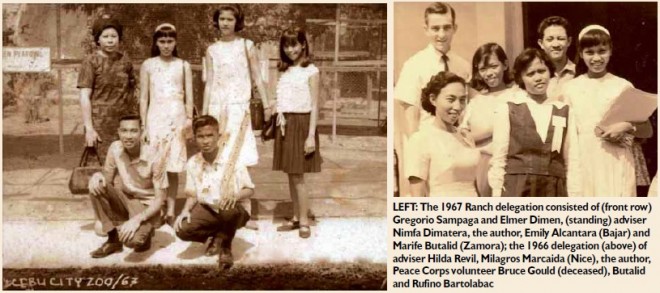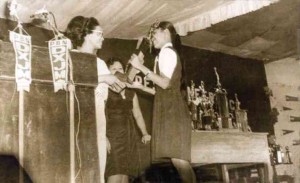Inspiring close encounters with working journalists
(Two alumnae of the National Schools Press Conference (NSPC) recall their participation in the journalism competition that has become an institution in the Department of Education. Their meets happened 45 years apart, but the feelings evoked by their recollections are the same—the thrill of meeting active journalists, the excitement of competing, the pleasure in making new friends, the joy of winning. As for the recently concluded NSPC, we will feature photos and winners next Tuesday.— Editor)
The National Secondary Schools Press Conference (NSSPC), now known as the National Schools Press Conference (NSPC), was a learning experience in more ways than one.
At that time, every province that could afford it sent a team to the conference, unlike today when delegations represent regions.
Our paper, The Ranch, was always Masbate’s representative to the national event my school, the Masbate High School (now the Masbate National Comprehensive High School), being generally acknowledged as the top secondary institution in our province.
Just like today, both the school paper and its individual staff members were in competition. The papers were judged before the conference and the individual contests were held on the spot.
Our student population kept us in Category B, medium-sized institutions which, at the time, meant schools with an enrollment of less than 1,500.
That meant we did not have to compete with traditional high achievers in the annual event—the Manila schools like Torres, Mapa, Araullo, etc.
I would think though that there were more medium-sized schools so, in terms of numbers, the competition was stiffer in Category B.
While I dreaded the idea of being pitted against scores of contestants, it was also exhilarating to be almost on my own for about a week. Before I attended the NSPC in Bacolod City (third year) and in Butuan City (fourth year), I had only gone on long trips with my parents, being an only child.
For the first time in my life, I travelled and shared living quarters with people who, while I knew them in school—and some were even neighbors —were virtual strangers. From the moment we got on the ship, throughout our stay in the conference host cities and until the return trip, we were a unit, whether we liked it or not.
Back then, we were billeted in a school in Bacolod and hosted by a local family in Butuan. It meant adjusting not just to having several roommates but also enjoying the hospitality of complete strangers.
The lessons I learned on those trips about sharing space with people I hardly knew would serve me well at the University of the Philippines Diliman where I stayed in boarding houses and dormitories the four years I spent there.
While the competitions were scary, there was no way I would have missed those two years of the NSPC. The resource persons were topnotch—real working journalists whose names were plastered on the front pages of the leading dailies almost every day. Some wrote cover stories for the top-selling magazines and periodicals. Others were editors whose names were listed at the top of editorial boxes.
It was exciting to finally match faces to bylines.
The resource persons were not theoretical journalists who learned about news writing from textbooks but practicing media people who had real deadlines to beat and worked in smoke-filled, cramped, noisy newsrooms.
I do not remember the names except for the late Kerima Polotan Tuvera, a personal favorite, but I do remember the awe I felt to be face to face with and to listen to people who did not even seem real until then, as I only knew them by what they wrote.
It would have been too much to expect that they could transfer to us in an hourlong lecture the skills they had honed over years of actual practice. In fact, some even had difficulty putting into words the things they learned by doing the work and probably wished they could instead show rather than tell us.
But for me, and I am sure for many other students, tales of actual newspaper work, untold stories behind major events, anecdotes about the powerful, the famous, the infamous and many more were just as instructive as actual writing tips.
Like the real working journalists that they were, almost everyone had to leave after his/her lecture and judging of the individual competitions to rush back to deadlines and scheduled interviews, hardly stopping even to look around the contest venue, much less the host city, although a few obliged to be photographed with some fans.
The conference seemed too small an event to draw such distinguished personalities but here they were. Apparently, for the veteran media people, being able to teach, inspire and encourage aspiring journalists was enough reason to push back a deadline and put other things on hold. Many of them confessed to having attended the conference when they were in high school so they were just too happy to give back.
The practical things we learned at the Bacolod conference were all that we brought home. But in Butuan, although we did not win in individual competitions, our modest paper (from what was probably an obscure province to people outside the Bicol region), won four trophies, if memory serves me right—for best editorial page, best sports page, best feature page and best layout.
As The Ranch’s editor in chief, I had the pride and pleasure of accepting the trophy from the then governor of Agusan, still a single province at the time, Consuelo Calo, for best editorial page.
It was probably the moment I finally decided once and for all that I was going to be a journalist.
Through the years, I myself have tried to give back to the conference that more or less sealed my fate. I have judged newspaper entries and individual competitions and conducted workshops to prepare competitors for the actual conference.
And I remain willing, able, even eager to contribute any way I can to the NSPC.

